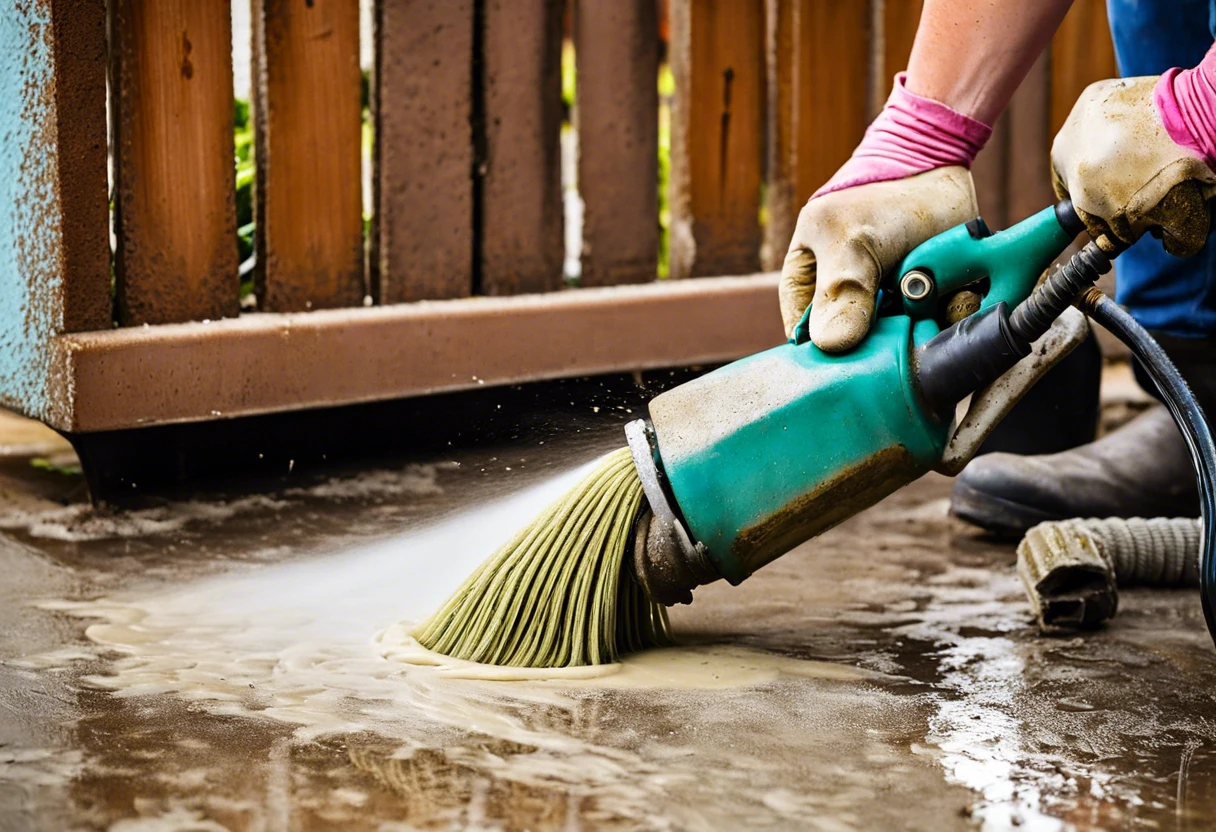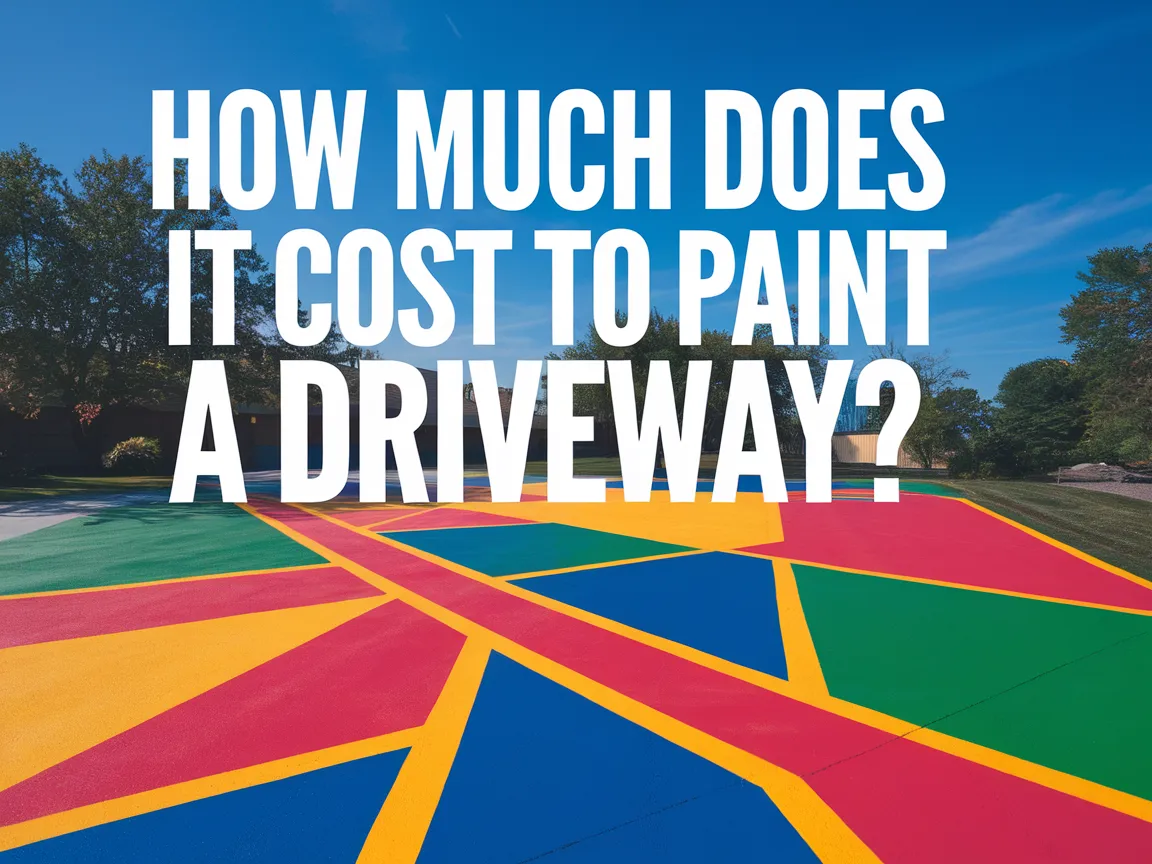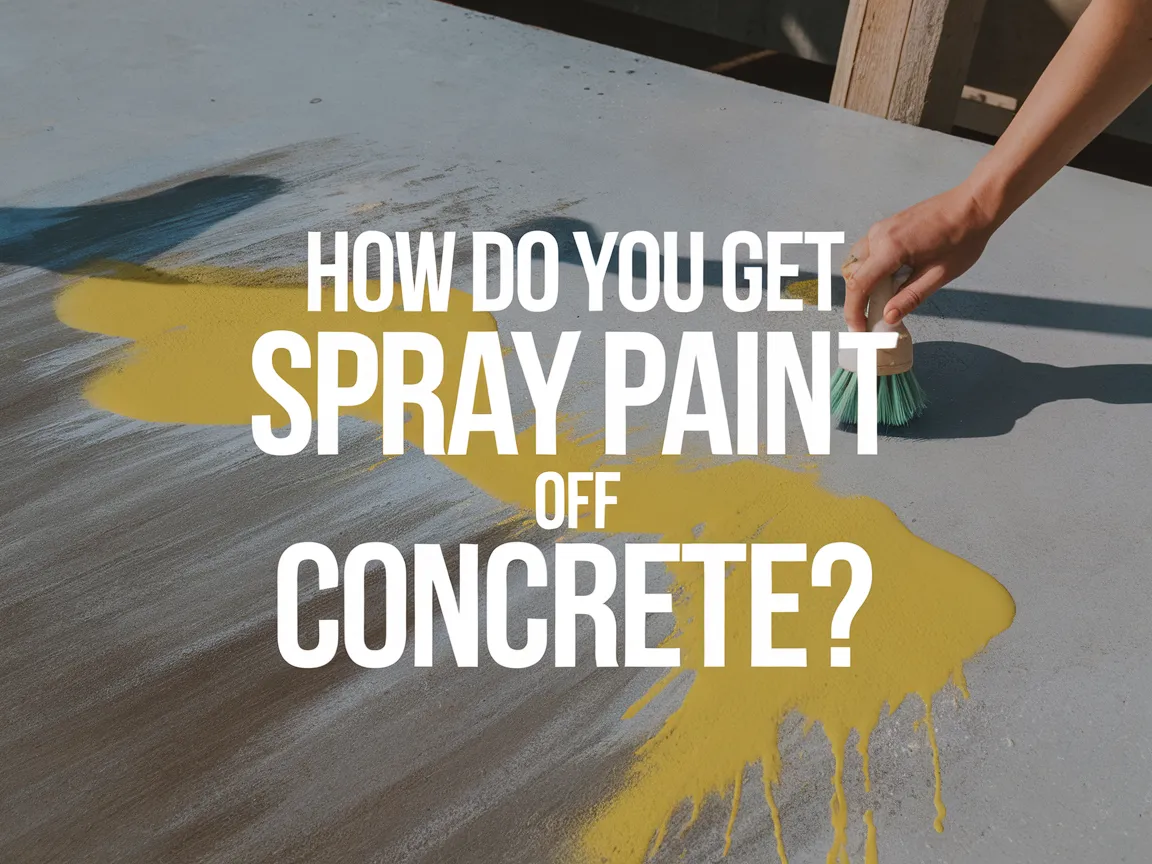Can You Get Paint Off Concrete?
Published on: June 12, 2025 | Last Updated: January 7, 2025
Written By: Isabella Cruz
Concrete is a tough, gray stuff we walk on every day. It’s made of rocks, sand, and water, all mixed together and dried to create floors, sidewalks, and driveways.
So, can you get paint off concrete? Knowing how to do this is super important because accidents happen, and I’ve been there, battling stubborn paint stains. Trust me, it’s a relief when you finally get that pretty floor back!
In this guide, you’ll learn how to remove paint from concrete, explore different types of paints often found on concrete surfaces, discover essential considerations for paint removal, and check out common issues when tackling this DIY task.
Contents
- 1 Can You Get Paint Off Concrete?
- 2 What is Concrete?
- 3 Before You Start: Essential Considerations for Paint Removal
- 4 Step-by-step Guide to Removing Paint From Concrete
- 5 Effective Techniques for Removing Paint from Concrete
- 6 Comparing Methods: Efficiency and Cost
- 7 Types Of Paint Commonly Found on Concrete
- 8 Factors Affecting the Ease Of Paint Removal From Concrete
- 9 Common Issues Encountered When Removing Paint From Concrete
- 10 Advanced Solutions for Stubborn Paint Stains on Concrete
- 11 Success Stories: Applying Advanced Techniques
- 12 Finishing Touches: Restoring Your Concrete Surface
- 13 Frequently Asked Questions (FAQs)
- 14 Conclusion: Successfully Removing Paint From Concrete Surfaces
- 15 Additional Resources
Can You Get Paint Off Concrete?
Yes, you can get paint off concrete surfaces. Use a paint stripper, pressure washer, or a mixture of vinegar and baking soda. For tough spots, sandblasting also works. Just remember, the sooner you act, the easier the job!
What is Concrete?
Concrete is a composite material made of aggregates, cement, and water. It typically consists of about 60-80% aggregates and 10-15% cement by weight. It gains strength over time through hydration, eventually reaching about 34 MPa (5,000 Psi) after 28 days.
Now, about getting paint off concrete—I’ve struggled with this myself. Once, I had a huge splatter during a DIY project, and I couldn’t believe the mess!
You might be surprised, but I actually used it for my patio renovation. Learning to remove paint from a concrete patio taught me patience and precaution. Techniques using household items helped tackle the paint without damaging the surface. By focusing on concrete, I found success with those pesky spills. Can you get paint off concrete? Trust me, it’s all about the right method! When tackling stubborn paint, I discovered some specialized professional painting tools and techniques that made the job much easier.
Before You Start: Essential Considerations for Paint Removal
What do you need to get started?
- Paint Stripper: You’ll need a strong paint stripper like Citristrip (1.3 L/44 Oz). It’s essential for breaking down tough paint on concrete.
- Scraper: A sturdy metal scraper, like the Warner Pro 15 cm scraper, is crucial for removing the paint after treatment.
- Protective Gear: Don’t forget goggles and gloves, such as MCR Safety goggles and 3M disposable gloves. They’re vital to protect you from harmful chemicals!
- Pressure Washer: If you have one, a pressure washer (About 2,000 PSI) helps wash the paint away efficiently after treatment.
So far we covered essential considerations for paint removal. Let’s look at the step-by-step process for removing paint from concrete next.
Also See: Can Galvanized Be Painted? Learn How to Do It!

Step-by-step Guide to Removing Paint From Concrete
Here are the steps to effectively remove paint from concrete.
-
Assess the Type Of Paint
Identify the type of paint on your concrete. Is it water-based, oil-based, or spray paint? Knowing this helps you choose the right remover.
For instance, oil-based paints need a stronger solvent, while water-based paints may come off with milder cleaners. Knowing the paint type allows for more effective work.
-
Test a Small Area First
Select a hidden section of concrete and apply your paint remover. Use a small amount to prevent long-term damage to the surface.
Observe how the paint reacts. Good removers will show results within a few minutes; this helps you determine the most effective option.
-
Apply the Chosen Paint Remover
Once you’re confident, coat the affected area evenly with the remover. Use a brush or spray for thorough coverage.
Let it sit for 10 to 20 minutes, depending on the product instructions. Patience is key—don’t rush to scrape too soon, or you’ll face a tougher challenge.
-
Scrape and Clean the Area
Use a scraper or putty knife. Start at one edge and carefully scrape the paint away, letting the remover work.
Repeated passes may be necessary. If some paint still clings on, reapply the remover and let it sit again for the best results.
-
Wash and Rinse Thoroughly
After scraping, clean the area with a hose or wet sponge. It’s crucial to remove any chemical residue.
Using warm water (23°C to 27°C or 73°F to 80°F) helps; a thorough wash will highlight your hard work!
We’ve wrapped up the steps for removing paint from concrete here. Let us turn our attention to effective techniques for paint removal.
Effective Techniques for Removing Paint from Concrete
There are several techniques to get paint off concrete. Each method has its own strengths based on the type of paint and concrete surface.
1. Chemical Paint Strippers
Chemical paint strippers can be really effective, especially on tough stains. Here are some common options:
- Methylene Chloride: This stripper works wonders but requires careful handling. It’s fast-acting within 20-30 minutes.
- Solvent-Based Strippers: These remove oil-based paints easily. Look for products labeled for concrete.
- Biodegradable Strippers: A safer option, though it may take longer (up to several hours) than harsher chemicals.
2. Mechanical Methods
Sometimes, you gotta get hands-on! Mechanical methods include:
- Sanding: Using a power sander can be effective. Use medium-grit sandpaper (around 80-120 grit) to avoid surface damage.
- Blasting: Sandblasting or bead blasting works well for stubborn old paint but requires professional help.
- Scraping: For less durable paint, a good quality paint scraper or putty knife can do the trick!
3. Pressure Washing Techniques
Pressure washing is a fantastic way to remove paint, especially with these tips:
- Optimal PSI: Use at least 2,000 PSI for effective paint removal without damaging concrete.
- Proper Nozzle: A 25-degree nozzle provides a good balance between power and surface safety.
- Pre-Soaking: Pre-soak the area with water or cleaning solution to loosen paint before pressure washing.
That covers effective methods for removing paint from concrete. Let’s now take a look at the efficiency and cost of these methods.
Comparing Methods: Efficiency and Cost
Let’s take a look at how these techniques stack up against each other.
| Method | Time Required | Cost (USD) | Effectiveness |
|---|---|---|---|
| Chemical Strippers | 30 min – 2 hrs | $10 – $50 | High |
| Sanding | 1 – 3 hrs | $30 (sander rental) | Moderate |
| Pressure Washing | 1 – 2 hrs | $50 (rental) | High |
| Scraping | 0.5 – 2 hrs | $10 (scraper) | Low – Moderate |
That covers efficiency and cost in comparing methods. Let’s now take a look at the various types of paint used on concrete.

Types Of Paint Commonly Found on Concrete
Let’s explore the various types of paint found on concrete: latex, epoxy, oil-based, and concrete stain.
-
Latex Paint
Latex paint is water-based and often chosen for its quick drying time, typically drying within 1-2 hours. Removing latex paint from concrete is straightforward, usually requiring just soap and water. If you’re curious about professional painters’ preferred paint brands, paint materials and techniques.
-
Epoxy Paint
Epoxy paint offers strong chemical resistance and durability. As a two-part mixture, it fully cures in 3-7 days, making removal more challenging. You’ll often ask, “Can you get paint off concrete?”
-
Oil-based Paint
Oil-based paint takes longer to dry, usually around 6-8 hours. It forms a tougher film, often requiring harsh solvents like paint thinner for removal from concrete.
-
Concrete Stain
Concrete stain penetrates the surface, providing a translucent finish but can be difficult to remove. Special concrete stain removers are often necessary, as water won’t easily lift its color.
From my experience, latex paint is the easiest to remove. I use a simple mix of soap and water because it’s quick and effective!
Factors Affecting the Ease Of Paint Removal From Concrete
What factors impact the ease of removing paint from concrete surfaces?
-
Type of Paint: The type of paint—latex, oil-based, or spray paint—greatly influences how easily it comes off.
-
Concrete Porosity: More porous concrete absorbs paint deeper, making removal trickier than on smoother surfaces.
-
Age of the Paint: Older paint bonds tightly with concrete, while newer paint’s easier to scrape off.
-
Weather Conditions: Heat and moisture can affect the efficiency of removal methods, such as solvents or pressure washing.
Common Issues Encountered When Removing Paint From Concrete
My friend tried to remove paint from his driveway but struggled with stubborn stains after years of wear. He only had partial success using store-bought products.
To fix this, using a pressure washer (2,000 PSI) with a strong degreaser can help. Try combining vinegar (5%) and baking soda to tackle those tough spots effectively!
Advanced Solutions for Stubborn Paint Stains on Concrete
If you have persistent paint stains that just won’t budge, consider these specialized methods.
1. Industrial-Strength Paint Strippers
For tough jobs, you might need to amp up your game.
- D-Limonene-based Strippers: These natural solvents are strong and eco-friendly, cutting through paint in about 30 minutes, with costs around $15-30 (USD) per quart.
- Biochemical Strippers: These take longer (1-4 hours) for complete effectiveness but are safer. Expect to pay about $40 (USD) for a gallon.
2. Specialized Tools for Deep Seepage
Some paint types really dig into the concrete!
- Floor Grinding: A diamond grinder can remove about 1/8-inch (3.2 mm) of concrete, costing around $100 per day for rental. It’s effective for sticky paint issues.
- Acid Wash: Using muriatic acid (1 part acid to 10 parts water) can help. This method takes about 15-30 minutes but requires careful handling. Costs around $10 (USD) for a quart.
Success Stories: Applying Advanced Techniques
Let’s see some real-world examples of success!
| Technique | Success Rate | Time Spent | Cost Estimate (USD) |
|---|---|---|---|
| D-Limonene Stripper | 90% | 30 min | $20 |
| Floor Grinding | 95% | 2 hrs | $100 (rental) |
| Acid Wash | 85% | 30 min | $5 |
Finishing Touches: Restoring Your Concrete Surface
After removing paint, seal your concrete with a solvent-based sealer, like Eagle’s Elite, at 4 oz per 100 ft² (0.37 L Per 9.2 M²). This protects against wear and water damage.
Inspect for uneven surfaces using a level; check for 1/8-inch (3.2 Mm) discrepancies. Correct any tool marks or sanding scratches to avoid future paint adhesion issues.
I recommend applying an epoxy overlay at 1/16-inch (1.6 Mm) thickness for durability. This provides excellent protection and is ideal for high-traffic areas.
Frequently Asked Questions (FAQs)
What Are the Best Solvents for Removing Paint From Concrete?
Yes, some of the best solvents for removing paint from concrete include acetone and methylene chloride. Acetone breaks down many types of paint effectively within minutes, while methylene chloride is specially formulated for tough paint problems, working in about 20 minutes. Wear appropriate gear; acetone can cost around $20 (USD) per liter.
Can I Remove Paint From a Concrete Driveway?
Yes, you can remove paint from a concrete driveway. Use a suitable solvent or paint stripper designed for concrete, as well as scrubbing tools. This method can restore your driveway’s look within a day, depending on weather conditions. If you’re curious about creative ways animals might interact with paint, check out some fascinating artistic animal experiments.
Is It Possible to Remove Stubborn Paint Completely?
Yes, it’s possible to remove stubborn paint completely from concrete. This may require multiple applications of strong paint strippers and vigorous scrubbing. Resultingly, you may regain a clean surface if the right products are used—typically yielding 95% or more paint removal for your projects. If you’re considering painting over concrete surfaces afterward, you might want to explore painting cement basement walls for additional guidance.
Will Paint Removal Damage My Concrete?
Normally, paint removal methods don’t seriously damage your concrete. However, strong solvents may penetrate the top layer if mishandled, causing minor surface etching. Use caution with powerful strippers to protect the surface and preserve your concrete’s longevity. When selecting the right paint for your project, you might want to explore specialized automotive silver paint options.
Can I Use a Pressure Washer to Remove Paint?
Yes, you can use a pressure washer to remove paint from concrete. A pressure washer with at least 2,500 PSI (Pounds Per Square Inch) effectively blasts away most types of paint, making it a powerful option for cleaning and maintaining your concrete surface. If you’re considering painting over concrete afterward, you might want to explore best painting techniques for surfaces.
How Do I Remove Spilled Paint From Concrete?
To remove spilled paint from concrete, act quickly with absorbent materials like rags or kitty litter to soak up excess paint. Afterward, scrub with a suitable solvent to dissolve what remains, ensuring a cleaner concrete surface for your space. If you’re dealing with challenging paint situations, you might want to explore alternative painting techniques.
How Can I Remove Old Paint From Cement?
You can remove old paint from cement using chemical paint strippers or sandblasting. Chemical strippers, like methylene chloride, provide effective results; sandblasting can fully restore either method, costing around $1-$2 (USD) per square foot.
Conclusion: Successfully Removing Paint From Concrete Surfaces
That concludes the information I wanted to share with you. We explored essential considerations, provided step-by-step guides, discussed various types of paint on concrete, examined factors affecting removal, highlighted common challenges, and suggested DIY project ideas for revitalizing your concrete.
My aim was to share valuable insights. So, can you get paint off concrete? Absolutely, various methods such as solvent removal or abrasive techniques can be effective, depending on the type of paint. With these tips and resources, you’ll find the task manageable and attainable.
For further detailed guides and tutorials, visit Paint Answers.
Additional Resources
- Smith, R. (2003). The Artist’s Handbook of Materials and Techniques (5th ed.). New York, NY: Knopf.
- How to Remove Paint From Concrete | Angi
Isabella is a Filipino-American art writer and critic specializing in contemporary painting, blending her Filipino heritage with global art trends. She holds a BFA from California State University, Long Beach, and a Minor in Art History from the University of the Philippines. Isa has experience as a Gallery Assistant, Art Appraisal Specialist, and Social Media Creative for Art & Design.
Concrete, Material




